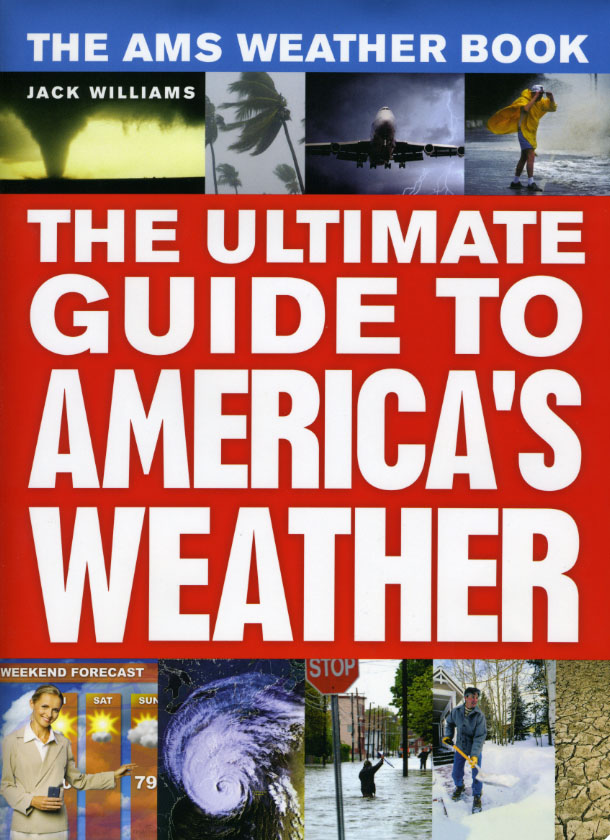Sources for Chapter 2
The books, Web sites, journal articles, and interviews listed on this page are sources of information other than facts and concepts found in most beginning college-level meteorology textbooks, which the author used or that could help readers better understand the concepts described. For more on various topics, including further reading and links to related Web sites, follow the links labeled “Explorations.” Links labeled “Outtakes” are to text from early drafts of the book that were dropped before publication.
In the notes below “the author” refers to Jack Williams, author of The AMS Weather Book.
Page 26
- Peggy LeMone profile: Based on the author’s interview with LeMone in her office, e-mail exchanges, telephone calls, and her Web site. Her detailed description of the puddle research described in the profile is on her GLOBE Chief Scientist’s blog in the archives for May 2007.
Page 27
- Rodger Fleming, Historical Perspectives on Climate Change (New York: Oxford University Press USA, 2005), 62–63.
- Arrhenius and CO2 and ice ages: Spencer Weart, “Greenhouse Speculations: Arrhenius and Callendar,” in The Discovery of Global Warming, Second Edition (Cambridge, MA: Harvard University Press, 2008), subsection 51.
Page 28
- All references in this book to the height of the sun in the sky are from the U.S. Naval Observatory (USNO) Web site, on the Data Services’ Sun or Moon Altitude/Azimuth Table page.
Page 29
- Twilight definitions: USNO’s Rise, Set, and Twilight Definitions page.
- Earth warmest in July when it’s farthest from sun: Explained in Science@NASA’s Distant Sun page.
Page 30–31
- Night and day graphics: USNO’s Day and Night Across the Earth page.
Page 32
- Minneapolis average temperatures: National Climatic Data Center’s (NCDC) Daily Station Normals—CLIM84 page for data for weather stations in all U.S. states.
Page 33
- Coldest temperatures in hemispheres: NCDC’s Global Measured Extremes of Temperature and Precipitation page.
- Explorations: Finding Climate Data
- Underground temperatures in the United States: Massachusetts Institute of Technology, Chapter 1 (PDF file) in The Future of Geothermal Energy (Idaho Falls, ID: Idaho National Laboratory, U.S. Department of Energy, 2006), Figure 1.4, 1–14.
- Effects of Mount Pinatubo eruption: “Chapter 2: Observed Climate Change and Variability,” in Climate Change 2001: The Scientific Basis, contribution of Working Group I to the Third Assessment Report of the Intergovernmental Panel on Climate Change (Arendal, Norway: GRID-Arendal, 2003), subsection 2.2.2.1.
Pages 34–35
- Earth’s Energy Budget graphic: Figures for incoming and outgoing radiation are from J. T. Kiehl and Kevin E. Trenberth, “Earth’s Annual Global Mean Energy Budget,” Bulletin of the American Meteorological Society (BAMS) 78 (February 1997): 197–208.
Page 36
- A different earth: NOAA’s Exploring Weather & Climate Change through the Powers of 10 page.
- Snowball Earth: Paul Hoffman, Snowball Earth Web site.
- Antarctica, Cretaceous period warmth: Brian T. Huber, “Tropical Paradise at the Cretaceous Poles?” Science 282 (December 18, 1998): 2199–2200.
- Plate tectonics: W. Jacquelyne Kious and Robert I. Tilling, This Dynamic Earth: The Story of Plate Tectonics (Washington, DC: U.S. Government Printing Office, 1996).
Page 37
- Antarctic fossils, including Glossopteris on Scott’s sled: Kristan Hutchison, “Early Explorers Left Rock Legacy (PDF file),” Antarctic Sun (December 28, 2003): 8. Most of the stories in this issue of the Sun are about scientists studying fossils left from a much warmer Antarctica.
- Outtakes: An Explorer’s Fossil Collection
- Moving Continents graphic: Kious and Tilling, Earth: The Story of Plate Tectonics, Historical Perspective page.
Page 38
- Arctic cooling: Gerald H. Haug and Lloyd D. Keigwain, “How the Isthmus of Panama Put Ice in the Arctic,” Oceanus (2004).
- Alfred Wegener: Patrick Hughes, “Alfred Wegener (1880–1930),” NASA Earth Observatory Web site.
Page 39
- The Arctic Ocean Halocline graphic: Based on the author’s research for the Arctic Ocean Hides Icy Puzzles online graphic, USATODAY.com (2001), (click on the white triangle in the red circle on the upper-left side to animate the graphic, and then click on the numbers) and for his book The Complete Idiot’s Guide to the Arctic and Antarctic (New York: Alpha Books, 2003), 50–51.
- Milankovitch theory: USNO’s The Tilt of the Earth’s Axis and Its Elliptical Orbit page; John Imbrie and Katherine Palmer Imbrie, Ice Ages: Solving the Mystery (Cambridge, MA: Harvard University Press, 1979), 113–122, 141–152. In addition to describing the development of Milankovitch’s theory, this book puts the story in the historical and scientific context.
Page 40–41
- Judith Lean profile: Based on the author’s telephone interviews and e-mail exchanges with Lean and the May 13, 2003, U.S. Naval Research Laboratory press release on her election to the National Academy of Sciences.
Page 42
- Schwabe, Humboldt, and the solar cycle: David P. Stern, “A Brief History of Magnetospheric Physics before the Spaceflight Era,” Reviews of Geophysics 27 (1989): 103–114.
- Eddy, “… trail of broken hearts”: Jack Williams, USA Today: The Weather Book, Second Edition (New York: Vintage, 1997), 18.
- Eddy, links between solar activity and climate: Jack Eddy, “The Maunder Minimum,” Science 192 (June 18, 1976): 1189–1202.
- Brightness of faculae offsets sunspot cooling: P. Foukal and J. Lean, “The Influence of Faculae on Total Solar Irradiance and Luminosity,” Astrophysical Journal 302 (March 15, 1996): 826–835.
Page 43
- Space Weather graphic: Sources include Judith Lean, “Living with a Variable Sun,” Physics Today 58 (June 2005): 32–38; e-mail exchanges with Lean; NOAA’s A Primer on Space Weather page.
Page 44
- The sun and global warming: S. Solomon, et al., “Technical Summary” in Climate Change 2007: The Physical Science Basis, contribution of Working Group I to the Fourth Assessment Report of the Intergovernmental Panel on Climate Change (Cambridge and New York: Cambridge University Press, 2007), 60.
- Explorations: The Sun and Climate
- The sun’s violence: NOAA’s A Primer on Space Weather page and UCAR’s Windows to the Universe Space Weather page.
- Outtakes: Space Weather—A Twentieth-Century Discovery
Page 45
- Flow of energy: E. C. Pielou, The Energy of Nature (Chicago: University of Chicago Press, 2001), ix.

